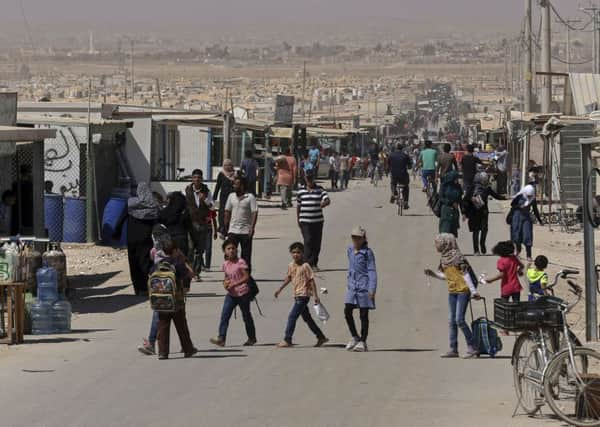Displaced youth a common thread in refugee crisis


The youth and community centre in Mafraq we were visiting bore all the hallmarks of a facility serving contemporary global youth: poster-bedecked rooms depicting preoccupations with cute animals, music idols and inspiring mottos; computer workstations to facilitate engagement with new technology and the virtual world; a diverse panoply of costume from traditional dress to the oversized Premiership football shirt; and a buzz of animation as staff corralled energetic youngsters from one planned activity to another.
This scene though, however ordinary, was being played out in extraordinary circumstances.
Advertisement
Hide AdAdvertisement
Hide AdMafraq is a Jordanian city just ten miles from the Syrian border, and its population has been swollen by the arrival and settlement of nearly 80,000 refugees. The programme of activities we are evaluating – the reason for my visit – is part of a major No Lost Generation initiative seeking to sustain the mental health, well-being and educational support of children threatened by the cataclysmic events in the region.
A small scuffle between two lads initially reinforced this image of the familiar and the ordinary. But its swift escalation, and especially the distorted, uncontrolled grimaces of the protagonists, hinted at the fear, loss and humiliation these youngsters were carrying.
This group of “new arrivals” had not only faced the perils of flight across insecure terrain, they had faced disorientation and potential marginalisation on arrival in the overcrowded conditions of Mafraq. Before that they had been hunkered down for years in their homes as the destruction and violence all around them daily informed the calculus of whether to flee to the unknown with nothing was preferable to the insecure, diminished reality of their current lives. Nearly half of the children we have assessed show symptoms suggestive of a mental health disorder. Losing their home and belongings, not being able to return to home and not being able to continue school are their major preoccupations.
I have visited scores of refugee situations as a researcher or representative of a United Nations or non-governmental agency since my first visit to a refugee camp in Malawi back in 1990. There are many consistent features such as the importance of the provision of basic food, shelter and healthcare; growing sensitivity to the toll of displacement on mental health and psychological well-being; the importance of engaging the significant skills and capacities of refugees in their settlement – temporary or extended – in a new country. But there are two major features of the current crisis which are unique. First, the global humanitarian system is faced by an unprecedented number of major “Level 3” emergencies; not just in Syria, but simultaneously in Iraq, Yemen, South Sudan and – at one stage earlier in the year – also in Nepal.
Second, the humanitarian system – and the respect of states for their signed treaty obligations of refugee reception and “burden-sharing” on which it depends – is showing clears signs of unravelling.
Funding to support kids in settings such as Mafraq – and the communities that are hosting them – is becoming severely restricted, as resources and focus get sucked towards other aspects of the crisis.
Discussions within Scotland, the UK and Europe regarding response to the current migrant crisis cannot be focused upon short-term, expedient measures to stem population flows or support temporary asylum. They need to acknowledge that the forces of globalisation have unleashed an interconnectedness that not only facilitates our ready identification with displaced youth in cities such as Mafraq, and those deciding upon a long, hazardous, uncertain trek West as the best of a number of bad options. That interconnectedness also means our destinies – our understanding of community, citizenship and the basis of security and our moral compass for the type of society in which we wish to raise our children – are wrapped up in the way we strategically address and resolve this situation in the coming years.
• Alastair Ager is director of the Institute for International Health and Development, Queen Margaret University, Edinburgh, and professor of population and family health, Columbia University, New York. He is currently researching the effectiveness of humanitarian programming targeting refugee children and youth through studies in Jordan with World Vision and Mercy Corps (the latter in collaboration with Yale University).
Advertisement
Hide AdAdvertisement
Hide Ad• The Institute for International Health and Development will share academic research on refugee integration at Shaping the Scottish Response to the Migrant Crisis, a QMU briefing for policy makers on 17 November.
Details available at www.qmu.ac.uk
SEE ALSO: